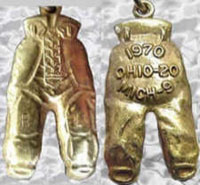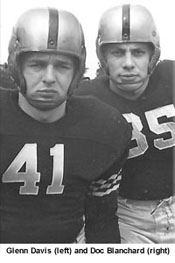CONTENTS
Odds 'n Ends
Halas Trades Eggs for Luckman
Most Played Rivalry
Gold Pants Charm
Pay Players Like Professors
Buy Me Out
Military Rose Bowls
Helluva Way to Ruin Your Career
Football:
Did You Know? I
Football: Did You
Know? II
Football: Did You
Know? III
Football: Did You
Know? V
Football: Did You
Know? VI
Football: Did You
Know? VII
Football Magazine
Golden Rankings Home
Top of Page |
Football:
Did You Know? – IV
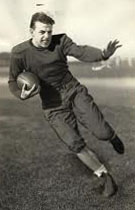
Bill Shakespeare |
- In 1961, TCU went 3-5-2. However, one of the victories was over #3 Texas, 6-0, and one of the ties was to #2 Ohio State, 7-7. The stumbles against the Horned Frogs cost the Buckeyes and Longhorns the #1 ranking in the final AP poll. Instead, 10-0 Alabama captured the crown.
- If I told you a college player was nicknamed "The Bard," what would you guess was his last name? If you said "Shakespeare," you win a purple popsicle. Furthermore, his first name was William. From Staten Island NY, William Shakespeare played HB for Notre Dame from 1933-5 and was elected to the College Football Hall of Fame in 1983. He won four battle stars and the Bronze Star during World War II.
- Alvin Wistert followed his two older brothers, Francis and Albert, to Michigan to play for the Wolverines. However, Al had a circuitous route to Ann Arbor. After dropping out of high school in Chicago, he took a test to get a general diploma from the state. He served in the Marines in World War II. After discharge, he used the GI Bill to attend Boston University where he lettered in football as a 6'3" 220 lb. 30-year old freshman T. He then transferred to Michigan where he was issued jersey #11 like his brothers. He helped Fritz Crisler's Wolverines win three straight Big Ten titles. His senior year, at age 33, he became the oldest player ever named an All-American. He later joined his two brothers in the College Football Hall of Fame. Michigan retired number 11 in honor of the Wisterts.
|
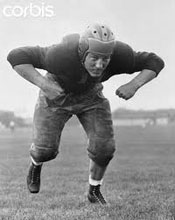
Al Wistert |
Halas Trades Eggs for Luckman
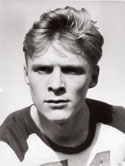
Edgar Manske |
Edgar "Eggs" Manske was a football star at Northwestern from 1931-33 and in the NFL.
- Edgar got the nickname "Eggs" as a boy. He grew up as one of nine children on a farm in Nekoosa WI. The children rotated through the farm jobs, one of which was bringing in the eggs from the henhouse. Edgar always brought in fewer than anyone else until they discovered he was eating as many of the raw eggs as he could. He was "Eggs" ever after.
- Edgar began his career at Northwestern as a walkon and ended it as a three-year letterman at end, team MVP, and All-American. He also made All Big Ten in basketball.
- Edgar was one of the last college players to compete without a helmet. (Helmets did not become mandatory in NCAA games until 1939 and in the NFL until 1943.)
|
- Manske started his pro career with the Philadelphia Eagles. After two years, he went to the Chicago Bears and there was involved in one of the most lopsided trades in NFL history. During the 1938 season, George "Papa Bear" Halas traded Manske to the Pittsburgh Steelers for their first round draft pick in 1939. When the Steelers finished the season with the worst record in the league, the Bears got to pick first and chose QB Sid Luckman from Columbia. To make matters worse, the Bears resigned Eggs for the following season. So Pittsburgh was left with nothing for its first round pick.
- Eggs' last NFL game was the Bears' 73-0 shellacking of the Washington Redskins in the 1940 Championship Game. He then served in the military in World War II.
- He married Jane Frauntz, a swimmer on the 1928 U.S. Olympic team and a medal winner in diving in 1932. After the war, he got into college coaching before finally becoming a high school educator.
|
Quick! What two teams have played each other the most often in college football history? You'll never get it because they aren't Division IA schools. It's Lehigh and Lafayette, two schools only 13 miles apart in Eastern PA.
- When the teams met in the 100th game of the rivalry in 1964, a Lehigh alumnus named Howard Foering attended his 91st game in the series. One of the sportswriters asked: "I wonder where he was the other nine games." Seven years later, Sports Illustrated wrote this.
Howard Foering, 104, of Bethlehem PA, who may be the oldest active football fan around, didn't make it to the big game this year, the one in which his alma mater, Lehigh, beat Lafayette 48-19. Still, his attendance record isn't bad. He has managed to attend 94 of the 107 games the two schools have played since 1884, and when he can't make one in person he manages to catch it on radio. Foering, class of 1890, spends his time between games playing bridge, watching games on TV, reading three newspapers and waiting impatiently for next year's big game.
Howard died in 1975 at age 106.
- The schools first met on the gridiron in 1884. There were a number of years early on when they met twice or even three times in the same season. That's why they have played 19 more times than Harvard and Yale, who began competing in 1875.
- The 2008 contest between the Leopards of Lafayette and the Mountain Hawks (or Engineers) of Lehigh will be #144.
Reference: Football Feuds: The Greatest College Football Rivalries,
Ken Rappoport & Barry Wilner |
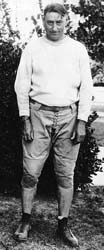 Francis Schmidt
Francis Schmidt |
Before the 1934 Ohio State-Michigan game, Buckeye coach Francis Schmidt created a famous sports cliche when he told his players that the Wolverines "put their pants on one leg at a time just like everybody else." UM had shutout OSU three straight times and were two-time defending national champions. So Schmitt was trying to give his charges some confidence.
When OSU won the game in Columbus 34-0, the first of four straight victories by a combined score of 114-0, each Buckeye gridder received a gold charm replica of football pants with the year etched on it. That tradition continues to the present day. Each charm is engraved with the player's initials, the date of the game, and the final score.
The QB of the 1934 team, Tippy Dye, was the only starting QB to beat Michigan three straight years until Troy Smith completed a trifecta in 2006. 91-year-old Dye was at Ohio Stadium that day to witness Smith clinch the Heisman Trophy and a spot in the BCS Championship Game for the Buckeyes. |
|
Reference: Football Feuds: The Greatest College Football Rivalries, Ken Rappoport & Barry Wilner |
Pay Players like Professors Louisville went 6-2 in the 1946 season but lost money on football. In September 1947, school President John W. Taylor made a startling proposal. He invited the presidents of 14 other urban colleges to join Louisville in an "out-and-out professional league." Taylor explained:
The players ... would be hired, just like professors ... [but] under rules as to age, salary, etc., to be agreed upon by the college presidents. It would work like this: suppose we find a great HB ... just graduating from high school. He wants a college education but he can't afford it. Maybe he prefers Xavier University to the University of Louisville. We sign him as a player on our professional team at, say, $4,000 a year and tell him he may go to school anywhere he likes, provided he is on time for all practices and all games.
In fact, under Taylor's plan, players would not have to go to college at all if they didn't feel like it. Some could even be graduates. Regular students could compete for places on the team with the professionals and would draw salaries too if they succeeded.
Taylor gave these advantages of the plan: "We simply would be providing better football entertainment, reaping more revenue from it ..." The president planned to commission a poll of Louisville fans to see what they thought of the idea. In the meantime, the Louisville Courier-Journal weighed in. While admiring Taylor's "blunt honesty," the writer found that:
Dr. Taylor overlooks some of the reasons for the sham of amateurism. Football players are less expensive when paid with scholarships. Besides the cash value, ... the prestige, popularity and coeducational opportunities of the successful campus athlete are premiums an honest system would find it hard to replace. And even if a team could be operated as cheaply with time-clock players, box-office figures prove that the old school try still outdraws the frankly professional game.
Taylor also got negative responses from his fellow presidents. Houston: "Not in favor." Cincinnati: "Neither feasible nor desirable." Chicago: "We got out of college football in 1939 and have no intention of returning."
Reference: "Just Like Professors," Time, September 22, 1947
|
File this story under "Some aspects of college football are not new."
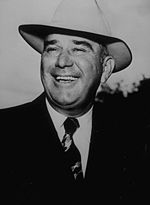
Homer Norton |
In Coach Homer Norton's 14th season, Texas A&M finished 4-6 in 1946, the Aggies' first losing season since 1942. Nevertheless, Norton came under fire from alumni despite the fact that he had led the Aggies to an 11-0 season in 1939 and a #1 ranking in the AP poll, then went 9-1 and 9-2 the next two seasons. The Aggies played in four bowl games from 1939-1943.
After A&M was beaten by archrival Texas 24-7 to end the '46 campaign, grads began yelling for Norton's scalp. He told them to put up or shut up because his $10,000-a-year contract still had three years to run. They backed down.
However, the 1947 campaign reignited the outcry. The Aggies finished 3-6-1 and lost at home to Texas 32-13. This time, alumni bought out Norton's unexpired contract and sent him packing. Far from being upset, Homer said the payoff was fine and "My best wishes go with them [the Aggies] always." Norton's 82 wins remain the second most in Aggie history. |
Post script: Under Harry Stiteler, A&M dropped to 0-9-1 in 1948. Interestingly, the tie was against Texas 14-14. 1949 brought a 1-8-1 mark including a 42-14 shellacking by the Longhorns. A&M rallied to 7-4 and a post-season "Presidential Cup" victory over Georgia 40-20 at the University of Maryland in 1950. However, they again lost to Texas 17-0, and Stiteler was replaced by Raymond George.
Reference: "Exit Homer," Time, December 29, 1947
|
The 1918 and 1919 Rose Bowls pitted military teams against each other for the service championship of the United States.
World War I put a crimp in college football because so many players enlisted in the military. Also, the general public looked askance on public fun while our boys were fighting in Europe. When Tournament of Rose officials asked the White House whether they should cancel the fourth Rose Bowl game, scheduled for January 1, 1918, George Creel, President Woodrow Wilson's publicity man, stated, "I don't know how such a celebration would interfere with the government's war activities." Then on November 23, 1917, Wilson sent a telegram to the Tournament President: "I think the normal life of the country should be continued in every way possible." So the association agreed to stage the game but promised to turn the net receipts over to the Red Cross.
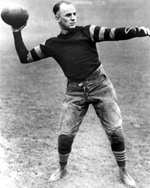 Paddy Driscoll
Paddy Driscoll |
1918 Rose Bowl: Theme "Patriotism."
- Former Oregon coach Hugo Bezdek returned to Pasadena two years after defeating Penn and his Mare Island (CA) Marines (5-0) defeated Camp Lewis Army (5-1-1), 19-7.
- FB Hollis Huntington was the star, gaining 111y on 20 carries. QB Jap Brown led the attack that offset the speed of Camp Lewis' Doug McKay and E. L. Romney.
1919 Rose Bowl: Theme: "Victorious Peace."
- Mare Island returned with a 10-0 record but couldn’t stop former Northwestern HB Paddy Driscoll, "The Wasp," who caught a TD pass, drop-kicked a 30-yard FG, threw a 45y TD to George Halas, and returned nine punts for 115y.
- Halas was also stopped at the 3 after returning an interception 77y as Great Lakes Navy (6-2) won 17-0 before 27,000 fans, which included servicemen in bleachers at the ends of the field who attended free.
|
 George Halas
George Halas |
|
Helluva Way to Ruin Your Career
|
Army coach Earl "Red" Blaik effusively praised Glenn Davis, one of his stars from 1943-6.
Anybody who ever saw Davis carry the football must realize there could not have been a greater, more dangerous RB in the history of the game. He was emphatically the greatest HB I ever knew. He was not so much a dodger and sidestepper as a blazing runner who had a fourth, even a fifth gear in reserve, could change direction at top speed, and fly away from tacklers as if jet-propelled.
- As a plebe (freshman) in 1943, the 5'9" 170 lb Davis scored eight TDs and finished seventh in the nation in total offense for his 7-2-1 Army team.
- He was dismissed from the academy in December for failing math. After several months of remedial work, he was readmitted in time for the next season.
- He scored a record 20 TDs in 1944 on the #1-ranked team.
- In 1945, he tallied 18 more TDs and, for the second year in a row, finished second in the Heisman Trophy voting, this time to his teammate, Felix "Doc" Blanchard, who was "Mr. Inside" to Davis' "Mr. Outside."
- Finally, his senior season, Davis won the coveted award after scoring 13 more TDs for West Point's third straight undefeated team.
|
It would seem that the blazing speed that made him such a terror in college would carry over to the NFL. However, Glenn played only two seasons, 1950 and 1951, with the Los Angeles Rams. Why such a short career? Was it the four-year layoff while he fulfilled his military duties? Not really. Instead, his lack of success in the pros is attributed to a knee injury that hampered his mobility. The circumstances under which he suffered the injury is one of the peculiar stories in football history.
In the summer of 1947, after their graduation from West Point, Blanchard and Davis were granted a 60-day leave to play themselves in the Hollywood production "Spirit of West Point." Glenn's knee injury occurred while filming the movie.
Reference: "Glenn Davis, Mr. Outside of Army Backfield, Dies at 80,"
New York Times, March 10, 2005
|
|
|
|




